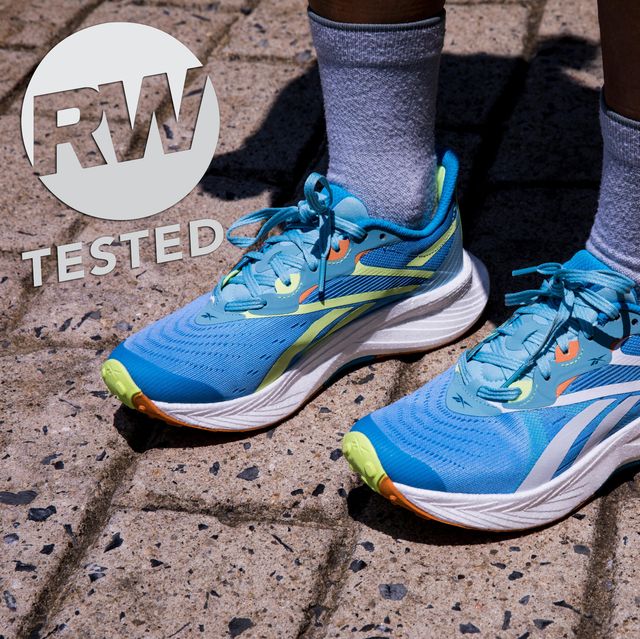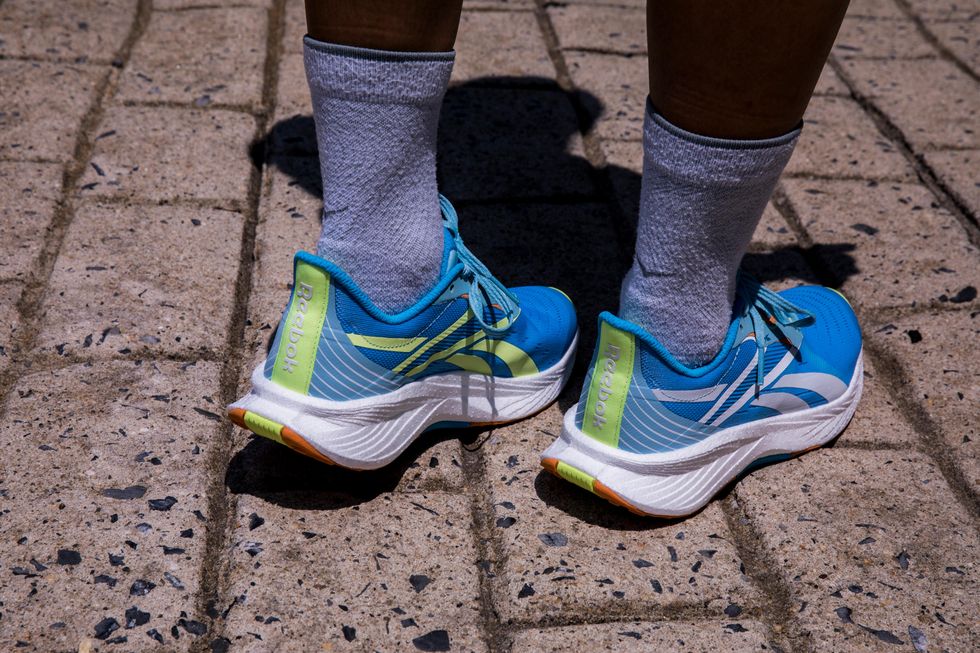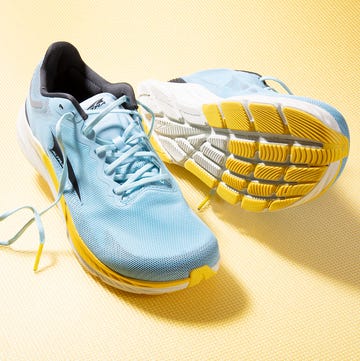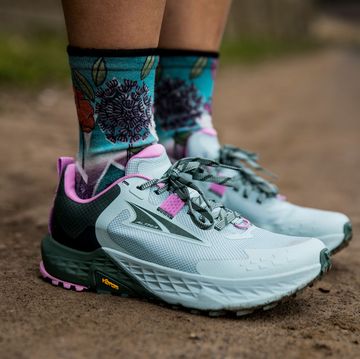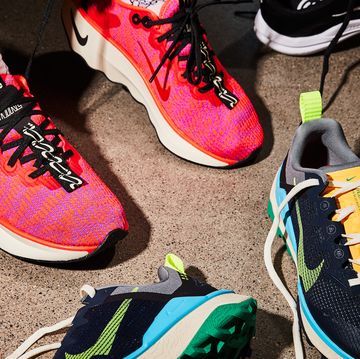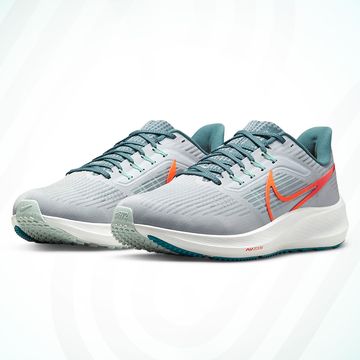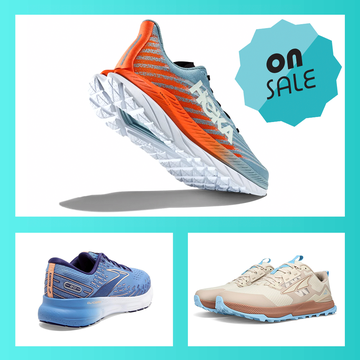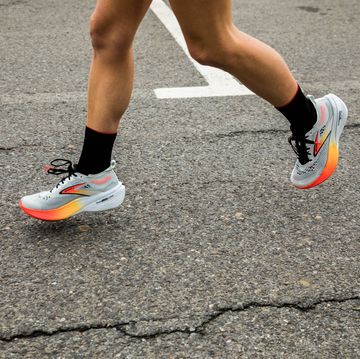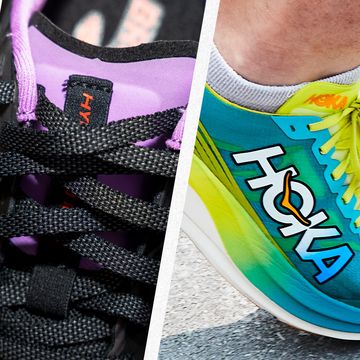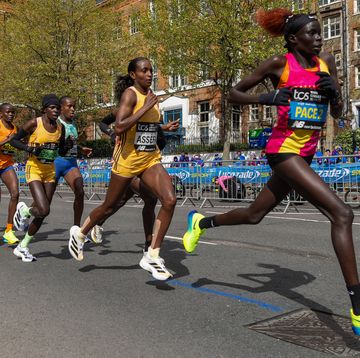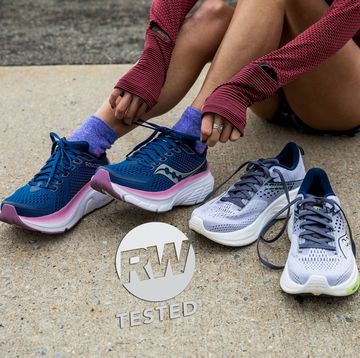With the standard training shoe priced at $160, great running shoes that cost between $100 and $120 are true unicorns in today’s world. The Floatride Energy 5 comes in at $110. Since its release almost five years ago, the Floatride Energy line has stood firm as the low-priced running shoe with premium value.
- Who It’s For: Runners looking for a bargain-priced pair without sacrificing top-shelf quality will find a solid, dependable base-building trainer in the Floatride Energy 5
- Preceded By: Floatride Energy 4
- For Runners Who Like: Nike Pegasus 40, Lululemon Blissfeel 2, Saucony Ride 16
- Key Feature: Midfoot X-plate for stability
- Midsole Foam: TPU-based Floatride Energy Foam
Reebok Floatride Energy 5 Overview
Five years ago, when I was new on the RW team, Jeff Dengate, RW’s director of product testing raved about Reebok’s Floatride Run Fast. Fellow test editor Morgan Petruny ran her first marathon in it. On our group runs we looked like a motley crew of wannabe Reebok-
sponsored runners, laced up in the shoe that would eventually earn Gear of the Year honors. The Floatride Run Fast was a good shoe—it was the first time I ran on a Pebax midsole—but, unlike Dengate, I wasn’t enthralled by its ride.
Soon after those Run Fast army runs, I strayed away from testing Reebok shoes, simply as a consequence of my job. Divvying up shoe testing with other editors kept me busy with other brands’ updates and launches for the next half decade. When I revisited Reebok, I was confused with its footwear’s naming conventions.
Somewhere down the line, “Forever Floatride Energy” was simplified to “Floatride Energy,” and “Floatride Energy Adventure” signified its trail counterpart. The Floatride Run Fast shoe? It’s now on its third iteration but has morphed into a model that feels nothing like the original. Add to the mix Reebok’s rendition of a carbon-plated super shoe, the Floatride Energy X, and all that is enough to make a gear editor’s head spin. In any case, the Floatride Energy 5 eventually landed in my hands, and here we are once again.
Floatride Energy vs. Floatride Run Fast
Compared to the Run Fast, the Floatride Energy isn’t as propulsive. Its midsole foam is made from a TPU-based material, which is not as responsive or lightweight as Pebax, but it’s a level up from traditional EVA. I felt a burst in my stride, and was surprised by my increasing momentum as I glided down my usual route. It’s a sure sign a shoe has the right formula and is made of the right stuff when you’re running faster without putting in extra effort.
Wear-tester Molly Sunderlin, who previously ran in the Asics Novablast and Nike ZoomX Invincible, praised the Floatride Energy 5 for its versatility: “They are soft enough to wear on a recovery day, and responsive enough to wear on a tempo run.”
Additionally, the Floatride Energy 5 now has a plate beneath the midfoot, which provides stability for erratic footwork when fatigue sets in an hour or so into a long run.
- Con: Less Comfortable “Step-In” Feel
A small knock is the difficult entry into the shoe along with some midfoot tightness. I tend to run in Brooks, Hokas, and Topos for testing, and perhaps my wide feet aren’t used to Reebok’s narrower lasts. There was some pressure on my instep, but it wasn’t too distracting during my runs.
Still, the Floatride Energy 5’s upper feels comfier than its previous two versions. It’s a return to the original Forever Floatride’s sturdier roots. To emphasize this, we go back to Floatride-obsessed Dengate. “I’ve always loved that Reebok shoe,” he said. “But V3 or 4 felt a little budget. This one is a return to cheap thrills.”
+ Pro: Versatility
“They have such a unique look,” commented RW photographer Thomas Hengge during a photoshoot for the Floatride Energy 5.
He’s not referring to a pointy heel collar that looks like a sports car’s spoiler, nor a special rearfoot geometry that implies dynamic turnover. The Floatride Energy 5 is a simple everyday trainer that’s capable of hard tempos and intervals, long runs and recovery jogs alike. It’s because of its versatility that I reach for the Floatride Energy 5 any time I’m not already pressed to test other shoes.
Our tester, Sunderlin, felt the same way.
“I think it’s quite versatile. Some shoes I would save for only slow recovery days or faster workout days, but the Reeboks could be chosen, in my opinion, for either,” she said. “Although they are pretty lightweight, I still feel like there is something substantial under my foot. They are soft enough to wear on a recovery day, and responsive enough to wear on a tempo run. If I were going on a trip and could only bring one shoe, I think I’d take this one.”
+/- Pro and Con: Narrow- and Wide-Footed Runners Had Different Fit Experiences
One aspect of the Floatride Energy 5 that Sunderlin and I didn’t see eye-to-eye on was the shoe’s fit. At times, I’d feel my pinky toe rubbing the inside of the shoe. During these moments, I’d feel the only thing standing in the way of perfection of the Floatride Energy 5 was a roomier toebox.
Sunderlin, on the other hand, desired a narrower fit throughout the shoe. However, she suggests her fitting issues may take root from the shoe’s lacing.
“This shoe is a little roomy in the toebox, but maybe this relates more to the small issue of the lacing system,” said Sunderlin. “I find that it is difficult to make fit adjustments with the laces—it could be the material or the stiff eyelets which the laces loop through. But moving and pulling on the laces is a little challenging, and it doesn’t seem to improve the snugness to make the slight adjustments I am looking for.”
But perhaps you can chalk up our different experiences to differing foot types. Sunderlin also noted some arch problems running in the shoe. She has a high arch, strikes with her midfoot, and underpronates. I have a wide foot, a medium-height arch that’s on the flatter end of the spectrum, and a neutral footstrike.
With these observations, runners with narrower feet and high arches may want to use an orthopedic insert to truly reap the benefits of Reebok’s versatile trainer.
Amanda is a test editor at Runner’s World who has run the Boston Marathon every year since 2013; she's a former professional baker with a master’s in gastronomy and she carb-loads on snickerdoodles.
